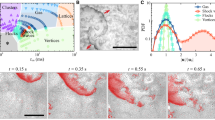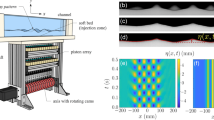Abstract
Since the discovery of crispations on a vibrating fluid layer, numerous types of patterns formed on fluid surfaces have been revealed. Here we report the observation of polygonal patterns of Faraday waves in vibrating water containers with parabolic and other concave bottoms. These patterns manifest themselves as simple geometric figures of symmetries ranging from elliptical up to heptagonal, with wavelengths much larger than the capillary length. Hence, they are intrinsically different from the previously studied patterns in vibrating drops or puddles and represent a particular variety of nonlinear shallow-water gravity waves or tidal waves in concave basins. Of specific interest is their resemblance to the collective excitations recently discovered in a driven Bose–Einstein condensate, not only sharing identical square-root scaling dispersion and pattern dynamics but also possessing similar nonlinear features like hard-spring nonlinearity. Based on the close correspondence, we propose an analogue of the patterning dynamics for classical and quantum fluid systems subject to confinement and argue that the analogy is mathematically valid even in the nonlinear regime.
This is a preview of subscription content, access via your institution
Access options
Access Nature and 54 other Nature Portfolio journals
Get Nature+, our best-value online-access subscription
$29.99 / 30 days
cancel any time
Subscribe to this journal
Receive 12 print issues and online access
$209.00 per year
only $17.42 per issue
Buy this article
- Purchase on Springer Link
- Instant access to full article PDF
Prices may be subject to local taxes which are calculated during checkout




Similar content being viewed by others
Data availability
The videos of selected experiments and simulations are provided with the supplementary materials.
Code availability
The OpenFOAM case files and the code for simulations of the unified model are available at https://github.com/lxynju/Polygon.
References
Ellegaard, C. et al. Creating corners in kitchen sinks. Nature 392, 767–768 (1998).
Morison, A., Labrosse, S. & Choblet, G. Sublimation-driven convection in Sputnik Planitia on Pluto. Nature 600, 419–423 (2021).
Noblin, X., Buguin, A. & Brochard-Wyart, F. Triplon modes of puddles. Phys. Rev. Lett. 94, 166102 (2005).
Singla, T. et al. Dynamics of a vertically vibrating mercury drop. AIP Adv. 9, 045204 (2019).
Steen, P. H., Chang, C. T. & Bostwick, J. B. Droplet motions fill a periodic table. Proc. Natl Acad. Sci. USA 116, 4849 (2019).
Bergen, J. E., Basso, B. C. & Bostwick, J. B. Leidenfrost drop dynamics: exciting dormant modes. Phys. Rev. Fluids 4, 083603 (2019).
Shen, C. L., Xie, W. J. & Wei, B. Parametrically excited sectorial oscillation of liquid drops floating in ultrasound. Phys. Rev. E 81, 046305 (2010).
Okada, M. & Okada, M. Observation of the shape of a water drop on an oscillating Teflon plate. Exp. Fluids 41, 789–802 (2006).
Christiansen, B., Alstrom, P. & Levinsen, M. T. Ordered capillary-wave states: quasicrystals, hexagons, and radial waves. Phys. Rev. Lett. 68, 2157 (1992).
Edwards, W. S. & Fauve, S. Patterns and quasi-patterns in the Faraday experiment. J. Fluid Mech. 278, 123 (1994).
Binks, D. & van de Water, W. Nonlinear pattern formation of Faraday waves. Phys. Rev. Lett. 78, 4043–4046 (1997).
Staliunas, K., Longhi, S. & De Valcárcel, G. J. Faraday patterns in Bose-Einstein condensates. Phys. Rev. Lett. 89, 210406 (2002).
Maity, D. K. et al. Parametrically excited star-shaped patterns at the interface of binary Bose-Einstein condensates. Phys. Rev. A 102, 033320 (2020).
Engels, P., Atherton, C. & Hoefer, M. A. Observation of Faraday waves in a Bose-Einstein condensate. Phys. Rev. Lett. 98, 095301 (2007).
Nguyen, J. H. V. et al. Parametric excitation of a Bose-Einstein condensate: from Faraday waves to granulation. Phys. Rev. X 9, 011052 (2019).
Zhang, Z., Yao, K.-X., Feng, L., Hu, J. & Chin, C. Pattern formation in a driven Bose-Einstein condensate. Nat. Phys. 16, 652–656 (2020).
Kwon, K. et al. Spontaneous Formation of Star-Shaped Surface Patterns in a Driven Bose-Einstein Condensate. Phys. Rev. Lett. 127, 113001 (2021).
Stringari, S. Collective excitations of a trapped Bose-condensed gas. Phys. Rev. Lett. 77, 2360–2363 (1996).
Jin, D. S., Ensher, J. R., Matthews, M. R., Wieman, C. E. & Cornell, E. A. Collective excitations of a Bose-Einstein condensate in a dilute gas. Phys. Rev. Lett. 77, 420–423 (1996).
Onofrio, R. et al. Surface excitations of a Bose-Einstein condensate. Phys. Rev. Lett. 84, 810 (2000).
Lamb, H. Hydrodynamics 6th edn, 291–293 (Cambridge Univ. Press, 1975).
Westra, M. T., Brinks, D. J. & van de Water, W. Patterns of Faraday waves. J. Fluid Mech. 496, 1–32 (2003).
Rajchenbach, J., Clamond, D. & Leroux, A. Observation of star-shaped surface gravity waves. Phys. Rev. Lett. 110, 094502 (2013).
Hechenblaikner, G. et al. Observation of harmonic generation and nonlinear coupling in the collective dynamics of a Bose-Einstein condensate. Phys. Rev. Lett. 85, 692 (2000).
Landau, L. Theory of the superfluidity of helium II. Phys. Rev. 60, 356 (1941).
Bogoliubov, N. N. On the theory of superfluidity. J. Phys. (USSR) 11, 23 (1947).
Saint-Jalm, R. et al. Dynamical symmetry and breathers in a two-dimensional Bose gas. Phys. Rev. X 9, 021035 (2019).
Fultz, D. An experimental note on finite-amplitude standing gravity waves. J. Fluid Mech. 13, 193–212 (1962).
Benjamin, T. B. & Ursell, F. The stability of the plane free surface of a liquid in vertical periodic motion. Proc. R. Soc. Lond. Ser. A 225, 505–515 (1954).
Ciliberto, S. & Gollub, J. P. Chaotic mode competition in parametrically forced surface waves. J. Fluid Mech. 158, 381–398 (1985).
Meron, E. & Procaccia, I. Theory of chaos in surface waves: the reduction from hydrodynamics to few-dimensional dynamics. Phys. Rev. Lett. 56, 1323 (1986).
Feng, Z. C. & Sethna, P. R. Symmetry-breaking bifurcations in resonant surface waves. J. Fluid Mech. 199, 495 (1989).
Kambe, T. & Umeki, M. Nonlinear dynamics of two-mode interactions in parametric excitation of surface waves. J. Fluid Mech. 212, 373–393 (1990).
Stoker, J. J. Water Waves: The Mathematical Theory with Applications, Vol. 36 (John Wiley & Sons, 1992).
Ursell, F. The long-wave paradox in the theory of gravity waves. Math. Proc. Camb. Philos. Soc. 49, 685 (1953).
Mei, C. C. & Le Méhauté, B. Note on the equations of long waves over an uneven bottom. J. Geophys. Res. 71, 393 (1966).
Katopodes, N. D. & Wu, C. T. A model for unidirectional water waves. J. Eng. Mech. 112, 697 (1986).
Thacker, W. Some exact solutions to the nonlinear shallow-water wave equations. J. Fluid Mech. 107, 499 (1981).
Whitham, G. B. Nonlinear effects in edge waves. J. Fluid Mech. 74, 353–368 (1976).
Liang, Q. & Marche, F. Numerical resolution of well-balanced shallow water equations with complex source terms. Adv. Water Resour. 32, 873–884 (2009).
Wang, Y., Liang, Q., Kesserwani, G. & Hall, J. W. A 2D shallow flow model for practical dam-break simulations. J. Hydraul. Res. 49, 307–316 (2011).
Liang, Q. & Borthwick, A. G. Adaptive quadtree simulation of shallow flows with wet-dry fronts over complex topography. Comput. Fluids 38, 221–234 (2009).
Fraccarollo, L. & Toro, E. F. Experimental and numerical assessment of the shallow water model for two-dimensional dam-break type problems. J. Hydraul. Res. 33, 843–864 (1995).
Bush, J. W. M. Pilot-wave hydrodynamics. Annu. Rev. Fluid Mech. 47, 269–292 (2015).
Sáenz, P. J. et al. Emergent order in hydrodynamic spin lattices. Nature 596, 58–62 (2021).
Yeh, H. H. Experimental study of standing edge waves. J. Fluid Mech. 168, 291–304 (1986).
Guéry-Odelin, D. & Stringari, S. Scissors mode and superfluidity of a trapped Bose-Einstein condensed gas. Phys. Rev. Lett. 83, 4452–4455 (1999).
Maragò, O. M. et al. Observation of the scissors mode and evidence for superfluidity of a trapped Bose-Einstein condensed gas. Phys. Rev. Lett. 84, 2056–2059 (2000).
Acknowledgements
We acknowledge S. Guo for her help with the experiments. This work was supported by the National Science Foundation of China under Grant No. 12174191. We are grateful to the High Performance Computing Center of Nanjing University for carrying out the simulations on its blade cluster system.
Author information
Authors and Affiliations
Contributions
X.W. supervised the research. X.W. and X.L. conceived the experiments. X.L. performed the experiments and simulations. X.W. and X.L. analysed the data and wrote the paper.
Corresponding author
Ethics declarations
Competing interests
The authors declare no competing interests.
Peer review
Peer review information
Nature Physics thanks Leonardo Gordillo and the other, anonymous, reviewer(s) for their contribution to the peer review of this work.
Additional information
Publisher’s note Springer Nature remains neutral with regard to jurisdictional claims in published maps and institutional affiliations.
Supplementary information
Supplementary Information
Supplementary Discussion, Figs. 1–10 and Table 1.
Supplementary Video 1
Experimental observation of polygonal patterns in a relatively small paraboloidal container of diameter 20 cm.
Supplementary Video 2
Experimental observation of polygonal patterns in a large Chinese steel pan of diameter 50 cm.
Supplementary Video 3
Direct numerical simulation based on Navier–Stokes equations for real water exactly as same as the experiment in Supplementary Video 1 and for ideal fluid of no dissipation.
Rights and permissions
Springer Nature or its licensor (e.g. a society or other partner) holds exclusive rights to this article under a publishing agreement with the author(s) or other rightsholder(s); author self-archiving of the accepted manuscript version of this article is solely governed by the terms of such publishing agreement and applicable law.
About this article
Cite this article
Liu, X., Wang, X. Polygonal patterns of Faraday water waves analogous to collective excitations in Bose–Einstein condensates. Nat. Phys. 20, 287–293 (2024). https://doi.org/10.1038/s41567-023-02294-y
Received:
Accepted:
Published:
Issue Date:
DOI: https://doi.org/10.1038/s41567-023-02294-y
This article is cited by
-
Weird waves in water emulate those in quantum matter
Nature (2023)




